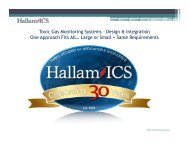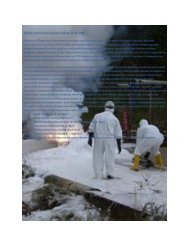SESHA 2011 Program Book - Semiconductor Safety Association
SESHA 2011 Program Book - Semiconductor Safety Association
SESHA 2011 Program Book - Semiconductor Safety Association
Create successful ePaper yourself
Turn your PDF publications into a flip-book with our unique Google optimized e-Paper software.
sponsored by IBM found that contact with less than 1<br />
milliliter of a 12% or 25% TMAH solution was lethal<br />
within 3 hours. IBM investigated possible underlying<br />
mechanisms of acute systemic toxicity including the direct<br />
effects on neurotransmission and on blood gases.<br />
IBM took prompt action to assess and, where necessary,<br />
enhance the health and safety procedures associated<br />
with TMAH based on the results of these animal studies.<br />
IBM notified the US EPA under the significant new<br />
information provisions of the Toxic Substances Control<br />
Act, Section 8e. Furthermore, IBM modified internal<br />
chemical labels for formulations containing TMAH,<br />
sponsored chemical-resistant glove and coverall permeation<br />
testing on TMAH solutions, performed process<br />
reviews on specific TMAH-using operations, and notified<br />
employees and contractors of the potential hazard.<br />
IBM implemented vigorous controls on the introduction<br />
of new processes employing concentrated TMAH<br />
solutions. Senior management is briefed on the potential<br />
hazards of the process, the tool and engineering<br />
requirements, and the availability of potential alternatives<br />
to TMAH. IBM develops work plans to reduce or<br />
eliminate potential TMAH hazards. In addition, IBM is<br />
working in cooperation with several development partners<br />
and suppliers to identify less hazardous alternatives<br />
to TMAH.<br />
4:30 pm The Integration of a Toxic Gas Monitoring<br />
System into the Building Fire Alarm System<br />
Sweeney, J; Harvard University<br />
Many facilities have toxic gas monitoring systems<br />
(TGMS) with local strobes to evacuate just clean rooms<br />
and affiliated areas. However, many facilities do not integrate<br />
their toxic gas monitoring systems into the building<br />
fire alarms systems. This presentation will describe<br />
three different types of toxic gas monitoring systems in<br />
a university setting and will describe how all three systems<br />
are integrated into the perspective building fire alarm<br />
systems. Topics of interest in this presentation will be as<br />
follows: 1. Details on TGMS Alarm level set points for<br />
exhaust and ambient gas sensors and when they trigger<br />
the building fire alarm systems; 2. Overview of how the<br />
two systems are integrated 3. Reasons for integrating the<br />
two systems; 4. Training details for all personnel involved<br />
in this new integrated system. In a university setting, the<br />
various working groups involved during emergencies<br />
are more expansive than in an industry setting. Types of<br />
people trained on the system (campus police, local fire<br />
fighters, facilities personnel, university operations center<br />
(24/7 hotline), EH&S department responders, building<br />
occupants etc).<br />
9<br />
1:45-5:15 pm<br />
GHG<br />
Sonora C<br />
1:45 pm Compliance Techniques for New Greenhouse<br />
Gas Regulations<br />
Higgs, T; Intel<br />
New greenhouse gas regulations pertaining to<br />
emissions reporting and facility permitting will impose<br />
multiple new requirements on semiconductor manufacturers<br />
and others in the electronics industries. The mandatory<br />
reporting rule for additional sources of fluorinated<br />
greenhouse gases (40CFR Part 98, subpart I) will<br />
require new approaches for measuring emissions, tracking<br />
inventories of fluorinated gases and heat transfer fluids,<br />
and add extensive new recordkeeping and reporting<br />
requirements. The Prevention of Significant Deterioration<br />
and Title V Greenhouse Gas Tailoring Rule (40CFR<br />
Parts 51, 52, 70 et. al.) will subject many sources to major<br />
source permitting requirements that have previously<br />
been able to avoid such requirements. These sources are<br />
likely to experience greatly increased requirements to<br />
understand and manage emissions impacts of routine<br />
changes, and significantly increased monitoring, reporting<br />
and recordkeeping burden. This presentation will<br />
examine compliance techniques for meeting the new<br />
requirements, and possible approaches for reducing the<br />
burden.<br />
2:30 pm PFC Stack Emissions Testing<br />
Inloes, S; WaferTech<br />
The goal of this testing was to determine if stack<br />
testing could be used to replace recipe specific testing<br />
required in the federal reporting rule. During February<br />
of <strong>2011</strong>, the SIA stack testing subcommittee developed<br />
the various stack testing options for testing emissions<br />
from electronic manufacturing Fabs. Various test methods<br />
were considered with the criteria determined to be<br />
1-10 ppb detection level . This equated to Fab emission<br />
of 1,000 to 40,000 MT CO2 eq depending on the Fab’s<br />
exhaust rate. Our site used GM/MS method to determine<br />
the concentrations of PFC’s and collection the samples<br />
using Summa containers. This method requires one-two<br />
days of onsite sample collection by a local emission testing<br />
company. Our process PFC emissions are routed to<br />
five acid scrubber stacks. In April of <strong>2011</strong>, we tested<br />
the five acid scrubbers simultaneously to reduce any<br />
variability of the site wide data. During the collection<br />
of the samples daily PFC gas usage data was collected<br />
and tier 2 emissions were compared to stack test results.




